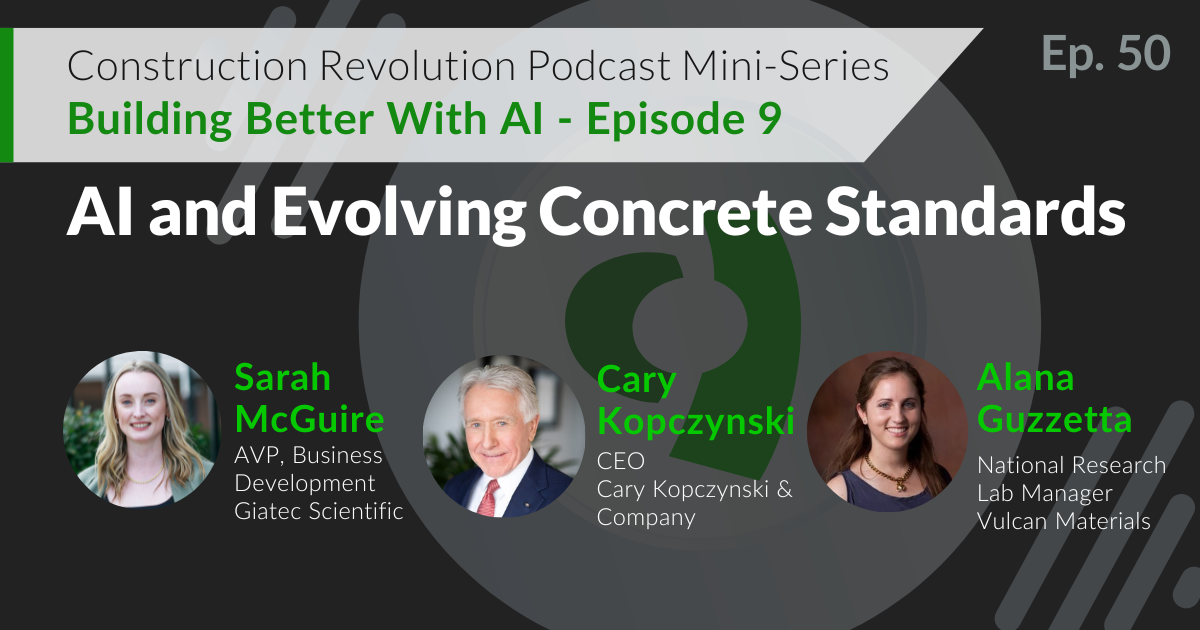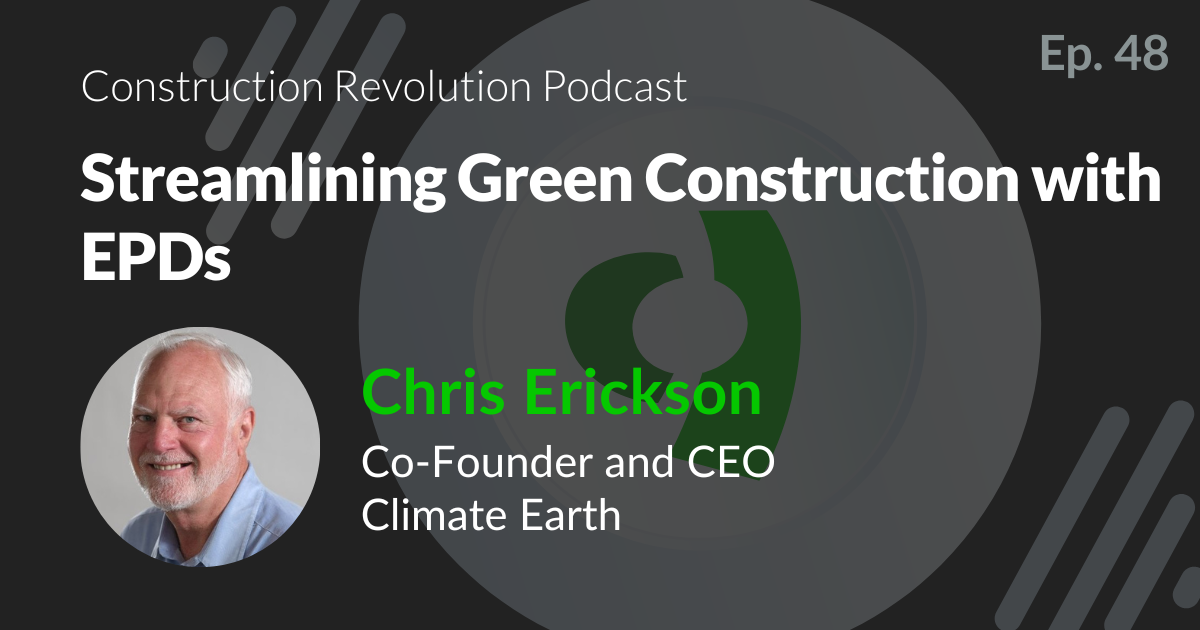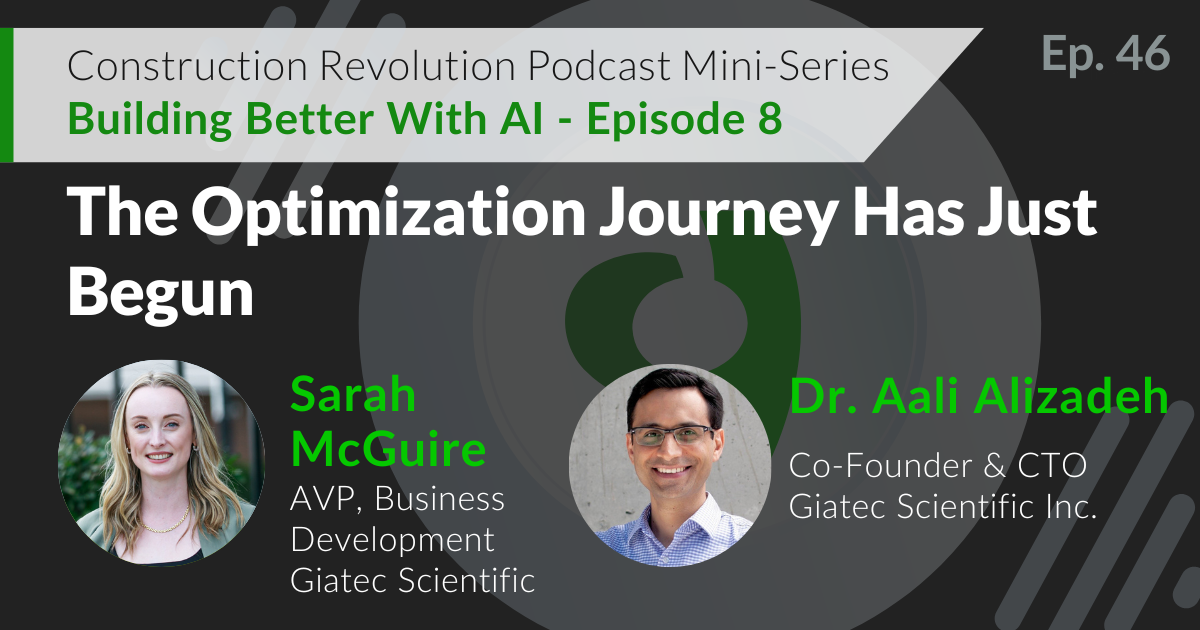
Episode 11 |
May 27, 2021
Reducing the Carbon Footprint of the Concrete Industry
In This Episode
In this episode of Construction Revolution, we are joined by Christie Gamble, the Senior Director of Sustainability at CarbonCure Technologies, where she drives the company's mission to reduce 500 megatons of annual carbon emissions from the cement and concrete industry. As one of the two recipients of the $20 million global five-year NRG COSIA Carbon XPRIZE, CarbonCure manufactures technologies that enable concrete manufacturers to utilize post-industrial carbon dioxide and reduce the carbon impact of their infrastructural projects without compromising concrete quality. Christie provides a detailed breakdown of the scientific process involved in repurposing carbon in concrete production as well as the logistics of providing these services to manufacturers through their market development team. She also emphasizes the importance of creating ambitious but viable goals towards carbon neutrality.

Host
ERIC YEE
Content Marketing Manager, Giatec Scientific Inc.

Guest
CHRISTIE GAMBLE
Senior Director of Sustainability, CarbonCure Technologies
Podcast Transcript
Eric:
Hello there and welcome to the Construction Revolution Podcast. My name is Eric Yee, and here on the show, we explore the latest trends, technologies, people, and organizations that are revolutionizing or disrupting the construction industry and changing what the industry will look like tomorrow. Today on the show, I’m speaking with Christie Gamble, the senior director of sustainability for CarbonCure Technologies. Christie Gamble drives CarbonCure’s mission to reduce 500 megatons of annual carbon emissions from the cement and concrete industry.
CarbonCure manufactures a technology that enables concrete providers to utilize post-industrial carbon dioxide in their manufacturing processes in order to achieve significant embodied carbon reductions without compromising concrete quality. In her role, Christie collaborates closely with designers and builders who seek to reduce the carbon impact of their buildings and infrastructure projects. Christie holds a BA from McGill University and MBA from Dalhousie University.
Christie, I want to start off by congratulating you and the team at CarbonCure for being one of the winners of the Carbon XPRIZE. It seems that the company, this was a huge undertaking that spanned years.
Christie Gamble:
It really is, and thank you. We’re so excited to have been named one of the two winners of the $20 million global five-year NRG COSIA Carbon XPRIZE. It has been a long time in the making. I can remember some of the first discussions we had about it, talking about this cool type of competition that was underway and thinking, “Do do we stand a chance at it?” And just thinking about what has changed within our company, not only within the XPRIZE competition and how our technology developments that we used within the competition really evolved, but also just how the company evolved in that time. And it’s an amazing accomplishment and I’m so proud of the team for what we were able to do.
Eric:
So could you maybe talk a little bit more about the technologies that CarbonCure uses? So from what I understand, CarbonCure injects recycled CO2 into fresh concrete to help trap that CO2 and it actually strengthens the mixes. How does that technology work?
Christie Gamble:
Sure. Well, first of all, CarbonCure is on a mission to reduce the carbon footprint of the concrete industry. We are working with concrete providers across north America and parts of the globe to beneficially utilize carbon dioxide in concrete production. What that means is the technology that we have installed in over 300 plants today is taking carbon dioxide that’s being captured from an industrial emitter. So this is typically today, an ethanol plant or a fertilizer plant. We take that captured purified CO2, and we introduce it into the concrete as an admixture. What happens is when we introduced the CO2 into the concrete, as an admixture, a chemical reaction occurs right away where that CO2 converts into a mineral. It’s a calcium carbonate mineral that becomes permanently embedded in the concrete.
So this is good for two reasons. One, we’re taking what would otherwise be a greenhouse gas, we introduce it into concrete. It turns out concrete has the unique chemical property of being able to convert CO2 into something else. And so we’re able to permanently get rid of that CO2. It will never be re-released into the atmosphere because it no longer exists. It’s being turned into a stone that’s now embedded in the concrete. What’s perhaps more important for concrete producers is that this whole mineralization process improves the concrete’s compressive strength and this allows concrete providers to optimize their cement content.
Cement is the key ingredient in concrete. It’s the ingredient that gives concrete its strength. It also happens to be the most carbon intensive and most expensive ingredients within concrete. And so the strength enhancement of the CO2 allows concrete producers to use a little bit less cement while still maintaining the same strength as they had before. So ultimately, this provides even further carbon benefits because we’re able to avoid the CO2 footprint that comes from cement itself. It also helps to offset the cost by being able to see a material cost saving that comes from the CO2 and that offsets the cost of the technology, the CO2. So at the end of the day, the concrete that’s delivered to construction sites is the same concrete, but just less carbon. And that’s really what we’re all about, is finding ways to reduce the carbon footprint of concrete in a way that makes business sense for the concrete producers for the end users and in a way that’s not compromising the concrete’s quality by any means.
Eric:
So from what I’m understanding, cement is one of the primary admixtures used to get to those target strengths that ready-mix producers are trying to promise to their general contractors. But by adding CO2 in, they can reduce their cement content because that mineral that’s produced also helps it gain strength. So you can reduce the amount of cement that’s needed, correct?
Christie Gamble:
Correct, yes. And so cement is the way that concrete gathers strength. They’re both, there’s ordinary Portland cement and other kinds of cementing materials. So one of the great ways to be able to reduce the carbon footprint of concrete is to use a supplementary cementitious material. So these are materials like fly ash and slag that are byproducts of other manufacturing processes that have the chemical ability to enhance the strength of concrete, just like cement. So oftentimes, we see concrete that’s made with a portion of cement and a portion of fly ash and or slag. CarbonCure enhances the strength of the concrete, so the CO2 enhances the strength of the concrete, and this allows the concrete producer to be able to use even a little bit less cement. So it is compatible with the other supplementary cementitious materials. Ultimately, it’s about achieving the same strength, but in the most optimal way possible for not only the quality, but also for the cost consideration, as well as for the carbon footprint.
Eric:
It really does kind of seem like a win-win for everybody involved to get involved with CarbonCure and to do this because there’s no real downsides from what I’m hearing, at all.
Christie Gamble:
At the end of the day, it’s just concrete. We’re really about supporting concrete producers to be able to continue to make the same wonderful material that they’ve been producing for a number of years. Concrete is the most abundant man-made material on the planet. It is, in my opinion, a very sustainable product because of the fact that it allows us to live in dense urban centers. It has a great thermal insulation properties. It’s extremely resilient, which is such an important element to sustainability is being able to withstand the elements of nature. And so concrete is a great product for sustainability, but it does have a carbon footprint associated with it because of cement production and the carbon intensive process required to make cement. So we’re working with these concrete providers to be able to reduce that carbon footprint so that we can continue to build with concrete and use it for all of the amazing properties that it provides.
Eric:
You mentioned that CarbonCure, you source your CO2 from emitters like fertilizer plants, or ethanol plants. So the onus for, let’s say producers to get the CO2 onto their sites wouldn’t be on the producers, it’d be on CarbonCure to provide it?
Christie Gamble:
How it works right now is we work with third-party industrial gas suppliers. So these are gas suppliers that have been operating for decades, capturing CO2 from typically ethanol plants and fertilizer plants. It’s captured from these sources because those are the most economically feasible ways of capturing CO2 and the CO2 right now, this industry it’s CO2 that’s being captured from these emitters, purified and then sold to various industries, including, most commonly, the carbonated beverage industry. So Coca-Cola, Pepsi, beer companies, these are all products that are using CO2 that’s initially captured from an ethanol or fertilizer plant, which I realize sounds super appetizing. But I can assure you, I’ve had enough beer to – you know – we’re good to go, don’t worry about it.
What’s important to note is that this industry exists already and it’s existed for a long time. But it hasn’t been able to generate environmental benefits because in these other applications like carbonated beverages or in the heating and cooling systems and other kinds of industrial processes, the CO2 remains a gas, which means it eventually makes its way back to the atmosphere. So we are tapping into this existing, reliable CO2 supply source, and we introduce it into the concrete where it chemically converts into a mineral, and we get rid of it.
Logistically, how it works with a concrete provider is when a concrete producer decides to partner with CarbonCure, we connect them to their local CO2 suppliers and they determine which CO2 supplier to engage in a simultaneous contract with. They then get that CO2 sourced and provided to their plant site. So the CO2 provider will install a tank at every concrete plant where our technology’s installed and they’ll refill that tank on a regular basis with this purified CO2. Inside this tank, it’s actually pressurized. And so it’s a liquid CO2 that they’re refilling. They’re just coming by with their trucks and refilling that CO2.
Eric:
Wow, that’s interesting. Yeah, it seems like the infrastructures are there in place, it’s just a matter of tapping into it now, then, these new plants.
Christie Gamble:
Yeah. And that’s been really key to our scalability, to our growth is the fact that this CO2 supply infrastructure is already existing. We don’t have to create that. And so it means that anywhere in the world where there’s Coca-Cola and Pepsi, there’s the ability to put that CO2 into concrete.
Eric:
I’m going to say Christie, I’m going to think twice the next time I open a Pepsi. The next time I do, I’m going to think of you, for sure. So CO2 doesn’t seem like something that producers would normally add to their concrete mixes. How does it work with other admixtures and the producer’s existing batching software?
Christie Gamble:
Sure. Well, it’s all integrating into existing batch and operations and working with existing materials. And this is another key element to our business, is we really focus on making this as seamless a transition as possible. So starting with the technology side, how it works is a concrete producer decides to partner with us. We help them source the CO2 tank and get that tank installed. And then we install our technology. It takes about a day for us to come in and install the technology. And in fact, over the past year, one of the adaptions we have made, thanks to COVID, has been to install remotely, which has been quite successful. So we install the technology over the course of a day and then work with the concrete’s QC team to conduct a testing program to gather data and validate the technology and get ready for submittals.
So all of this is integrating with the existing batching software that exists at every single concrete plant. And it connects to that software, and what happens is when a concrete producer decides to make a load with CarbonCure, the software that’s integrated is delivering a precise dose of CO2 for that load based off of the load that’s being batched at that moment. So it’s delivering a dose of CO2, a precise dose of CO2, by weight of cement. So however much cement is in that mix, it’s delivering the precise dose for that particular mix. So that part is all pretty seamless. The easiest way to think of it, if you’re a concrete producer, is that it’s another admixture operating in the exact same way as another admixture that’s integrated into the system. We’re not impacting the cycle time or scheduling or anything like that. Now the second part of that question, what was the second part of that question Eric?
Eric:
I think you got it. It was other admixtures and then the batching software.
Christie Gamble:
Right. So the other admixtures and the other materials. Concrete in some ways is so simple. Concrete has just a few ingredients. It’s cement, it is aggregate like stone and sand, so fine aggregates, it’s water and then there are admixtures. The reality of concrete is it’s actually extremely complex. There are so many nuances to these materials, so many differences to these materials across different regions. And so there’s always variability in concrete.
We have, in our experience so far, produced over 10 million cubic yards of concrete. And we have come across a wide range of materials, different kinds of cements, different kinds of supplementary cementitious materials, different aggregates, different admixtures, different kinds of climates and conditions. Obviously, the concrete that’s been supplied in Calgary, Alberta has different freeze thaw conditions than the concrete that’s supplied in Honolulu.
Eric:
For sure.
Christie Gamble:
All of those things combined, so far to date, we haven’t come across a circumstance or an admixture, a material that is not compatible with CarbonCure. Who knows to say what we’ll see in the future, but we feel very confident that this is a universally applicable process and material. It’s CO2, it’s going to be the fifth ingredient in concrete.
Eric:
That’s awesome, I like that tagline. So if there’s a producer out there that wants to get started using CarbonCure, what do they need to do to get started? What does the process look like for them?
Christie Gamble:
Well, the easiest thing to do would be to reach out to us, so carboncure.com. There are all sorts of Contact Us forms on the website and speak with one of our regional sales directors to get that process started. Ultimately, the sales director will walk you through that process. We will then hook you up with a CO2 supplier. We’ll get the system installed. Our installation and engineering team will work through the onboarding process to make it as seamless as possible. And then we have a technical services and support team that works with the quality control team over a course of a couple of months, to validate the mixes, to figure out the optimal cement adjustments to the mix and collect data that can then support the submittals. We then have a market development team that supports the concrete producer to get that concrete out at construction sites.
So right away, typically, a concrete producer is able to use CarbonCure on all of their performance work, which is typically residential work. So something like a concrete driveway, for example, that’s often about a third of the concrete that any given concrete producer will provide. And that application right away is applicable for CO2 with a cement reduction. The next kind of application is in commercial work, so the various types of office buildings and warehouses and high-rises. We are supplying a lot of these types of projects across the country. Oftentimes though, we do need to go through an approval process with the engineers and the owners. And so the market development team provides the resources and the support to help concrete providers ensure that their submittals on these projects are approved and use CarbonCure as often as possible.
The final stage is that on the government side, so government itself procures about 40% of the concrete out there. All sorts of concrete is used in sidewalks and bridges and government buildings. And these kinds of applications are pretty prescripted, they’re pretty regulated. And so we approach these circumstances in a case by case, region by region basis, where we have a government affairs and a regulation compliance team, a regulatory compliance team, that is working to meet the regulatory requirements of these various types of public agencies. So for example, we have been approved by the Hawaii Department of Transportation, the Chicago Department of Transportation, Iowa Department of Transportation for the use of CarbonCure in these applications, and we’re really growing that side of the business. It’s the next frontier, is tackling the prescriptive regulatory challenges that exist in government procurement.
Eric:
I bet that’s probably a long hoop to jump through. But once you get through it, in that state, it probably just opens the doors to the possibilities, I would think.
Christie Gamble:
It really does. And we’re starting to see the process speeding up. It is one of those things where I think the first couple of DOTs are the hardest or the first couple of regulatory municipal agencies are the hardest ones. And then when there’s a precedent, it does become a lot faster and a lot easier. And we’re just starting to see that now that we have a couple of DOTs that have approved it some examples of various applications. And what’s also really important is we’re seeing the political willpower really begin to emerge as this awareness of embodied carbon becomes more forefront at the forefront of everyday conversation. So what we do know, getting into embodied carbon, is that embodied carbon, which is the carbon footprint of construction projects, so buildings and infrastructure, it’s the carbon footprint of these projects before the building comes into use for the first time.
So it’s the carbon footprint that comes from the building materials themselves and the construction. Historically, these weren’t as large a portion of the overall carbon footprint of a building because a lot of carbon was emitted through the heating and the cooling and the lighting systems. But those systems have become a lot more efficient. And as a result of it, the total carbon footprint, a big majority of that, or a big chunk of that is coming from embodied carbon. Over the next 40 years, almost 50% of the carbon footprint of any given building will come from embodied carbon. And so this knowledge has resulted in designers and owners and public agencies starting to collectively go, “What do I do to address this?” And this is resulting in policy that we’re starting to see creeping up in various locations, that’s addressing low embodied carbon concrete procurement, which is a really key part of this challenge.
Eric:
Yeah, I can see as that starts revving up in the specs of different projects where it would be really easy to turn to CarbonCure and be like, “Here’s the switch that I need to kind of meet those technical specs.” Absolutely, makes sense.
Christie Gamble:
Absolutely. And if you want to talk about the specification, so looking at if you’re a specifier, what can you do to support low carbon concrete innovation, there are many, many things that can be done. So first of all, being aware that embodied carbon is going to be 50% of the carbon footprint of that project over the next 40 years is a key component to understand, because not enough credit in the past or not enough attention in the past has been paid to this element. If you want to look at lead, for example, lead assigns about 100 points to reducing operational carbon and very few points to reducing embodied carbon. So there’s misperception of the significance of tackling this issue. So the first thing you could do is become aware of it and make a commitment to address it.
And the next thing is to communicate that commitment across the supply chain. It’s not easy to address embodied carbon because it really does take the village. There are many stakeholders in any given construction project, whether it’s owners, the contractors, the engineers, the building material manufacturers. So communicating, breaking down the barriers of communication across the supply chain is really key. Then once you make that commitment concrete, it represents such a great place to start for reducing embodied carbon. Because it is the most abundant material, because it’s often one of the highest volume products on any given building project. And because there are so many opportunities, so many strategies available to achieve significant carbon reductions in concrete, it is a great place to start. So the way to do that, there are a couple of things. First of all, developing or specifying with performance-based concrete specs.
So these are specs that would outline the performance that’s needed for this concrete. How strong do you want that concrete to be? What kind of exposure will this concrete have and what’s needed? What kind of durability is needed to make sure that that concrete is going to withstand the test of time against the various type of elements that it’s exposed to? Traditionally, a lot of concrete specs have been written with pretty prescriptive approaches. And so what I mean by that is it will prescribe how much cement is needed in the concrete.
Eric:
Interesting.
Christie Gamble:
And this is really outdated way of specifying concrete. It stems from decades ago when quality control standards, transparency was not as stringent as they are now. Now, we can very easily assess what the strength is of concrete going to a construction site. But before, that reassurance wasn’t there. And so what happened was the engineers would write into a spec, “Oh, well, I’d like 3000 PSI concrete, and just to make sure you’re getting there, I’m going to ask you to put 500 pounds of cement in your concrete mix,” which is more cement that’s necessary to meet that strength.
So that still is a really common practice. In fact, anywhere between 50 to 80% of concrete specs for commercial work have some form of prescriptive requirement. And that really limits the concrete producer’s ability to put forward in a sustainable innovations. This is the biggest challenge that we have at CarbonCure, is simply knocking down these prescriptive spec barriers. So we’re really asking engineers, government agencies, owners, anyone who’s involved in the construction project supply chain, to review their specification practices and to look at performance-based specs.
There are so many resources out there. se2050.org, so this stands for Structural Engineers, 2050, this is a group of engineers who are committed to reducing embodied carbon from structural elements. And so they have great resources on how to incorporate performance-based specs. The National Ready Mixed Concrete Association, nrmca.org, has a program called Specifications in Practice, which again, provides all sorts of information about how to transition from prescriptive to performance specs. So this is a huge, huge part of the challenge. And this is what I would really encourage anyone who’s in construction, whether it’s design or building, or contracting, whatever, to really look at, to figure out how to eliminate those barriers so that the concrete producers can propose and be encouraged to propose sustainable innovation.
Eric:
It definitely seems like a huge barrier because if those are what are in the specs and then the producer, they don’t necessarily have the ability to have that conversation to alter the specs. The specs are the specs, so they’ll just go with a different producer if you’re not going to throw those other 500 pounds of concrete in, or cement in. So I really like your approach to focusing on concrete and also the mentality that it takes a village. It’s not just a producer that needs to make the changes. It’s kind of everyone among us on the supply chain, which kind of makes me think about some of the research that I’ve seen that CarbonCure is doing. So you guys, you’re very well known for injecting CO2 into concrete mixes, but there’s a lot of things you’re doing beyond just that, at different stages. I’d love to learn more about what you guys are doing with capturing CO2 at cement kilns, but also carbonating reclaimed water from concrete plants. Because to me, that looks like almost the entire supply chain of developing concrete. Can you talk a little more about that?
Christie Gamble:
Absolutely. First of all, CarbonCure’s mission is to reduce 500 megatons of carbon emissions annually from the cement and concrete industry by the year 2030. So we’ve got less than a decade to do that. We’ll be able to achieve significant carbon reductions through the use of our current technology. But in order to get to 500 megatons, we need new innovation and we need global deployment. And so the new innovation that we have in our R&D and in some cases very early stages of commercialization, looks at novel ways to utilize CO2 as a beneficial material in concrete production. We recently won the Carbon XPRIZE, as we started off discussing. And in the Carbon XPRIZE, in the final round, we demonstrated our newest technology, which is CarbonCure for reclaimed water.
In CarbonCure for reclaimed water, we’re introducing CO2 into water reclaimers to repurpose the calcium and the cement that is part of this water slurry, so that we can then reuse that water and reuse some of the materials within it. And ultimately, we’re seeing significant carbon reductions, water reductions as well. And this will be a really critical innovation in our path to reducing 500 megatons. We have other kinds of innovations as well, that are in R&D. And we’ve outlined that path, how we’re going to get there, in our roadmap to 500 megatons. So we’re being quite transparent about what we are aiming towards and how we intend to do that.
Now, another aspect of this is that ultimately, the purpose, the overarching goal of the CO2 utilization industry, which is an industry that’s expected to be a trillion dollar industry over the next decade, and CarbonCure is currently the world leader in this industry, the goal of this industry is to create a demand for CO2 to be able to use CO2 to create products, to provide business value. And by doing so, we’ll create more opportunities for the CO2 emitters to be able to capture the CO2 and use it to be able to sell it or to find something beneficial so that there’s a value in capturing the CO2 so it doesn’t get up into the atmosphere in the first place. This is another aspect of just some of the innovation we’re exploring, is how can we support the capture of CO2 from new sources and particularly within the cement industry, cement, cement production itself emits about seven to 8% of the world’s CO2 emissions. And so we’re really exploring the opportunity to close the loop, capturing CO2 from cement plants and utilizing it downstream in concrete production.
Eric:
I think it’s a hugely ambitious goal. And I think it seems like such an interesting time, because I think a lot of people are fine to just let the CO2 emit into the air. But if there is incentive for them to capture it and maybe have some way to monetize their waste product, and that makes a ton of sense for them to do so as another potential revenue stream. So if you can create the demand for those CO2 products, it seems like such a fantastic path to try and get to those ambitious climate goals that we’ve seen other countries try to reach.
Christie Gamble:
And here’s the thing, Eric, is that this is the time to do it. We don’t have the luxury of time to wait. And the reason I say that is because the Paris Agreement outlined a carbon cap, so to speak, of how much carbon, it’s a carbon budget that we’re able to emit before the year 2050 in order to prevent global warming from exceeding two degrees Celsius. And we haven’t done enough in the last decade to reach that budget, which means we need to accelerate. And so this is driving so many cities and so many governments and private companies to create ambitious climate targets around carbon neutrality and reducing embodied carbon specifically. The progress that has been achieved over the past two decades has been fantastic, but it needs to be accelerated rapidly. And we know that embodied carbon itself really needs to see some rapid reductions in the next decade if we’re going to have a hope of reaching the goals that were set out initially by the Paris Agreement.
Eric:
It’s going to be a tough road ahead, but I think we can get there if we all work together at it.
Christie Gamble:
I’m optimistic about it too.
Eric:
Before I let you go, Christie, I was just going to ask, what role do you think designers, developers and governments play in supporting these low carbon concrete innovations?
Christie Gamble:
Well, the best thing you could do is to make commitments to reduce embodied carbon, communicate those commitments, and then follow through with real action. It’s one thing to say that embodied carbon is important to you, but you really need to look at the procurement policy or the specification practices that are used within your organization. And first of all, remove the barriers. Remove those prescriptive specifications, use performance-based specs. There are all sorts of great ideas about how to ask for environmental product declarations, which are kind of like nutrition labels that state the environmental impact of products. So where those are available, they provide great transparency into the carbon footprint of concrete and other types of building products. So asking for those and using that data to make procurement decisions. So create a model for how to incorporate carbon into the procurement process.
And I’m just going to give an example of that. There’s policy that I think does a really good job of striking the right balance between pragmatism and then ambitious carbon reductions, and that is LECCLA. So it’s the Low Embodied Carbon Concrete Leadership Act. And what LECCLA does, it creates procurement incentives for concrete providers to supply low carbon options. It asks for EPDs, it requires these environmental product declarations, but it also provides tax incentives to concrete providers who do that in order to offset those costs. And then what it does is it creates a matrix, a model for how to consider carbon alongside cost in a procurement process. So traditionally, the procurement is always awarded to the lowest cost option. Well, what’s happening now is that within LECCLA, if you have the lowest carbon option, it provides a little bit of allowance so that you might not have quite the lowest cost. But if you’re within a certain boundary, you may be given that preference for procurement.
And so it’s a really great way to manage costs while also providing incentives to concrete providers to reduce carbon. And I think this is a model that’s not only great for policy, but also for private organizations to consider how to incorporate carbon considerations into your procurement and specification practices. And of course, another thing that can be done is in procurement in specifications to allow for CO2 mineralization. So that’s the process that CarbonCure uses. Now, in an ideal world, it would be amazing if everyone out there required it, but that’s actually not what we’re asking for. What we’re asking is for specifications that allow the use of CO2 because that eliminates the barriers and eliminates the challenges that come when introducing new products to the market. And this will really accelerate the ability for concrete providers to do what they know makes sense, which is adding CO2 as the fifth ingredient in concrete.
Eric:
So essentially, if by adding that into the specs, it would increase the amount of innovators that might enter the market sort of thing, to try to come with these new novel solutions.
Christie Gamble:
Absolutely. Right now, it’s amazing how often we talk to concrete providers who say, “I really like to introduce new innovation to reduce my carbon footprint. It’s something that is important to me, but my market won’t allow it because my market is asking me for concrete that has 500 pounds of cement.” So we really need to collectively eliminate that barrier. And also too, to concrete providers, the message I would give is to challenge that. It’s amazing how often we’ve had success by encouraging and working with concrete producers to submit a concrete mix that might not be exactly the mix that’s prescribed on the spec, but meets the performance, supply the data, supply the motivation and the reason as to why this mix is being proposed and the impact it has on carbon reductions. We’ve seen an incredible amount of approvals that come from that. So I would encourage the specifiers to remove those barriers. I also encourage the concrete producers to challenge those barriers and to propose the concrete mix that they believe is the right concrete mix for that application.
Eric:
That’s kind of like how you said before, at every stage, at every touch point across the whole supply chain, we need to be having these conversations and pushing this conversation forward.
Christie Gamble:
Exactly. And the best thing you could do too, regardless of whether you’re a concrete provider, you’re an engineer, you’re an owner, is pick up the phone, call your local provider, see what they can do. I’ve seen some of the best innovation across the country has happened when a structural engineer and a concrete producer get together and put their brains together and say, “What can we do to make the best performing concrete with the lowest carbon footprint?”
Eric:
Yeah. Sometimes it’s just a matter of having those conversations. I know everyone’s so busy that they don’t take the time to do those things sometimes. But yeah, when you get two people together that have the same mission, the possibilities are endless sometimes.
Christie Gamble:
Absolutely. And the great thing is that at least we are seeing so many mission aligned organizations, whether it’s government, whether it’s the tech industry, some of the leaders in that like Amazon, Microsoft, Facebook, they’ve all made these public statements to reduce carbon. And it’s really, I think, accelerating the industry overall to take a look at this and to find ways to solve it collectively.
Eric:
Well, Christie, thank you so much for coming on the show today. It was a lot of fun. I learned a lot and I feel inspired that we hit these aggressive targets that we have to hit for climate change.
Christie Gamble:
Thanks, Eric. I really appreciate it.
Other Related Episodes
Episode 50 |
October 3, 2024
AI and Evolving Concrete Standards
Our “Building Better with AI” mini-series is back by popular demand! Originally planned as an eight-episode series, the overwhelming response from our listeners has brought us back for more. Please join us for our ninth episode, “AI and Evolving Concrete Standards”! In this episode, we’re unpacking the challenges of concrete constructability, why industry stakeholders must improve communication, and how AI can help bridge this gap. Joining us are Cary Kopczynski, CEO, Cary Kopczynski & Company, and Alana Guzzetta, National Research Lab Manager, Vulcan Materials. Together, they explore the impact of evolving ACI standards on concrete performance, constructability, and sustainability, along with the major opportunities and challenges that AI presents as the industry advances. Filled with insights and a call to action for the entire industry, this episode is a must-listen for professionals eager to stay ahead in the concrete world. Tune in for a conversation that’s not just about keeping up with change but leading it!
Full McKinsey Report:
REINVENTING CONSTRUCTION: A ROUTE TO HIGHER PRODUCTIVITYPLAY
Episode 48 |
August 22, 2024
Streamlining Green Construction with EPDs
In this episode of The Construction Revolution Podcast, we welcome Chris Erickson of Climate Earth. Chris shares how the latest advancements in Environmental Product Declarations (EPDs) are transforming sustainability efforts in the construction industry. With his extensive knowledge in environmental impact data and sustainable practices, Chris delves into the innovative tools and solutions that are simplifying EPD creation and management for construction companies. Join us as Chris discusses how Climate Earth’s technology is making it easier for companies to measure and reduce their ecological footprint, ensuring compliance with regulatory requirements and enhancing their commitment to sustainability. Don’t miss this insightful conversation on the future of sustainable construction and the role EPDs play in leading the industry towards a greener future.
PLAY
Episode 46 |
July 11, 2024
The Optimization Journey Has Just Begun
In the eighth and final episode of our "Building Better with AI" mini-series, "The Optimization Journey Has Just Begun," we’re introducing a unique twist. This time, Sarah McGuire, AVP Business Development, switches roles and steps into the hot seat to answer questions rather than ask them. To guide this special conversation, we’ve brought back our Co-Founder and CTO of Giatec, Aali Alizadeh, Ph.D. This episode provides a comprehensive update on where SmartMix, Giatec’s AI-powered mix management system, currently stands. Sarah and Aali discuss the significant progress made since recording the first episode in December 2023, highlighting the challenges overcome and valuable lessons learned during the implementation of SmartMix. Listeners will gain insight into customer success stories and the transformative impact SmartMix has had on the concrete industry. This episode offers a reflective and forward-looking perspective on the journey of SmartMix, showcasing how it continues to drive innovation and efficiency. Tune in for a compelling discussion that not only recaps our journey but also looks ahead to the future of AI in the concrete industry. Don’t miss this insightful and engaging conclusion to our mini-series!
PLAY
Want to Be a Guest Speaker, Sponsor, or Just Have a Question for Us? Fill In the Form!





